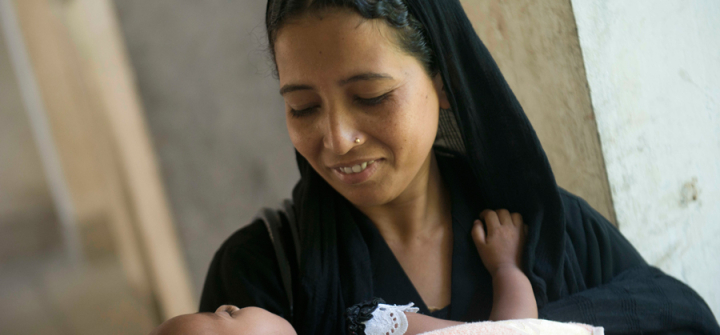A Not-So-Benign Feeding Ritual: Q&A with Alain Labrique, Maria E. Sundaram
The practice of giving prelacteal and early newborn ritual foods, common to populations across much of South Asia, parts of North Africa and the Arabian Peninsula, is not benign, and has serious implications for the immediate initiation of breastfeeding, concludes a study published in in the International Breastfeeding Journal in November 2016. While many public health experts have long demonstrated and advocated for immediate breastfeeding (<1h) as an evidence-based strategy against neonatal mortality, the new analysis found the practice is so prevalent (>85%) in a rural part of Bangladesh that it is often discounted when measuring immediate and exclusive breastfeeding. GHN’s Brian W. Simpson reached out to two of the authors—Alain Labrique, PhD, MHS, MS, an associate professor in the Department of International Health at JHSPH and the director of the JHU Global mHealth Initiative and Maria E. Sundaram, MSPH, now a graduate research assistant at University of Minnesota—to discuss the significance of the findings.
Why does prelacteal feeding delay breastfeeding?
AL: This practice has been documented around the world—mainly in parts of Asia and Northern Africa—as a deeply engrained cultural practice, usually to "sweeten" the voice, or to ward off evil spirits. The American Academy of Pediatrics strongly opposes giving some of the foods, such as honey, due to the risk of infant botulism. In the US, you'll find this warning printed on many honey labels. Our best guess as to why this practice delays breastfeeding is that honey is a calorie-dense food (64 calories per tbsp), and it may stave off crying, or even dampen the suckling reflex of the newborn when put to the breast. We've often seen family members feeding teaspoons of sugar-water, honey or commercial "fruit" drops (basically colored sugar water) in efforts to calm newborns who have not begun breastfeeding. In this analysis, we also made sure to adjust for the possible impact of "poor suckling," sometimes reported with low-birth-weight or premature newborns—a common occurrence in the population we work in, in Bangladesh.
MS: Just to add, in informal focus group discussions with JiVitA interviewers, we learned about the idea in the area that milk simply does not come in until 3 days after birth. In order to keep the baby from going hungry, women may feed something else as a stopgap measure. Unfortunately, our study doesn't clarify the direction of this relationship—whether prelacteal feeding delays breastfeeding, or whether delayed breastfeeding causes prelacteal feeding. Mothers in this setting are young (most are under 20 years old), may be undernourished, and their children may be premature or born with intrauterine growth restriction—all factors that would also make breastfeeding difficult. So in my opinion, our biggest takeaway is that women need more support as they start to breastfeed! We think of breastfeeding as being an easy public health intervention that needs little help and is a "natural" activity. In reality, women may need more support.
What does this mean for children’s health?
AL: While the practice is common, the health implications are, frankly, poorly characterized and understood. But they are likely to be substantial because prelacteal feeding can, by delaying breastfeeding, deprive the newborn of colostrum (a highly nutritious, protective and functional food that synchronizes the mother and newborn as an inseparable pair right after birth) and likely protects the newborn from disease-causing pathogens. Colostrum—the early breastmilk produced by new mothers—is uniquely formulated to offer numerous benefits to the newborn- including high levels of nutrients, energy, maternal protective antibodies and other factors that protect the GI tract of the infant (La Leche League FAQ). This early breastmilk is only extruded in the first several days of life, rapidly changing in character to 'normal' milk. Inadequate colostrum feeding may impede neonatal immune competence, especially critical in environments of high infectious risk—like the mud/thatch and tin homes most of these babies are born into.
Colostrum aside, the introduction on day 1 of potentially contaminated liquids is like adding insult to injury. Not only do we have newborns struggling against many challenges in the first weeks of life in a non-clinical, highly infectious environment, but we have family members purposely introducing substances that newborns are ill-equipped to digest, let alone pathogens they are not ready to fight. This may be leading to increased morbidity, mortality and poor infant growth in impoverished societies, but it is unclear at this time. We're in the process of unpacking large datasets collected over years of community-based research in Bangladesh to see if we can shed more light on this topic.
MS: Additionally, while this research did not focus on feeding colostrum, that would be a great next study topic—giving colostrum is a key component of early and exclusive breastfeeding. I absolutely second Alain's point that these non-breastmilk foods have the potential to expose infants to dangerous pathogens and toxicants very early in life. And historically, we've also failed to consider whether feeding prelacteals is a sign of difficulty breastfeeding overall. No matter what the reason, the child doesn't get to start off life with the best nutrition available. The good news is that this is a fixable problem.
Is the message here that the practice needs to be abolished or modified?
AL: Abolished is preferred. It has been difficult to study the effects of prelacteals at a population level given the ubiquitous nature of the practice. In massive studies like the JiVitA trials in which our group has been engaged since 2001 in Bangladesh, we are able to identify sufficient numbers of people who don’t feed prelacteals to make robust comparisons of outcomes—such as breastfeeding initiation presented in this paper. Although normative agencies will likely wait for more evidence to be presented, this data clearly presents a continued need for sound public health guidance and advocacy to both avoid this harmful practice and help mothers start breastfeeding right after giving birth.
MS: Also, this goes beyond just getting rid of prelacteals. Women who noted that their child had difficulty suckling at birth, but did not feed a prelacteal, still took 7 hours on average to start breastfeeding. What this says to me is that more overall support is needed for optimal breastfeeding.
With more than 85% of your study population engaging in the practice, how would you begin to change the cultural and behavioral norms around this?
AL: I think this insidious practice needs to be better and more often measured to gain the full attention of the scientific and public health communities engaged in breastfeeding promotion as one that may be preventing the full benefits of breastfeeding from reaching newborns. At present, most survey measures of "exclusive" breastfeeding used around the world brush aside prelacteal and early newborn ritual foods as nuisance practices that are nutritionally non-significant and either not assessed or considered violations of "exclusivity" We therefore tend to misclassify and, thus, grossly overestimate the prevalence of exclusive BF from birth in LMICs. As importantly, such misclassification may also underestimate the health benefits of true, exclusive breastfeeding for infants, given that early ritualistic feeding may deprive newborns of early colostrum that is exquisitely designed to support babies in the earliest days after being born. Plain and simple, feeding prelacteals should prevent an infant from being counted as having been exclusively breastfed. Part of the reason this has, perhaps, not been consistently done is a lack of data to suggest that a few teaspoons of honey or sugar water were of public health consequence. This now needs to be re-examined.
Changing norms is a difficult challenge for public health in general, but new strategies exist for reaching previously unreachable populations with new knowledge about risks, safety and best practices within cultural contexts. We have to learn from BCC experts and design interventions that inform the public, promote alternatives, and assist public health agencies and governments to account for prelacteals and ENFs when assessing, appropriately defining and estimating rates of truly exclusive breastfeeding.
MS: I totally agree with Alain's points--I'd love to see more emphasis on this in the public health community, and changing norms is one of the biggest challenges we're asked to face as public health professionals. A brief story: during my time in Bangladesh, I was able to talk with a young woman who had just given birth to her first child. I asked her if she knew about prelacteals and whether she was planning to give her child one. She said yes, she knew about them, and her mother-in-law had told her she should feed one, but a local health worker told her that it would be bad for her baby, so she refused her mother-in-law's advice. The glint in her eye when she told me this story helped me believe that young, educated women supporting each other as new mothers would be a great way to start changing the cultural norms around this practice.
I also think it's important to remember that historically, a lot of nutrition interventions have focused on education. This doesn't always help—sometimes women need more support than just knowing what is best, especially if nursing is hard due to malnutrition, young age, stress, premature infants, etc. Help for nursing (beyond education) could come from new mother support groups and from health care professionals that are trained to provide lactation help.
Join the thousands of subscribers who rely on Global Health NOW summaries and exclusive articles for the latest public health news. Sign up for our free weekday enewsletter, and please share the link with friends and colleagues: Subscribe to GHN
Mother and child at an Upazila Health Complex in Bangladesh. © 2013 Ismail Ferdous, Courtesy of Photoshare





